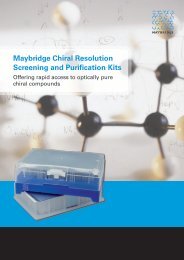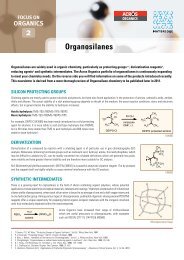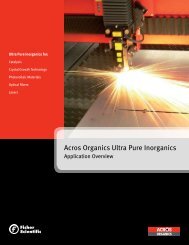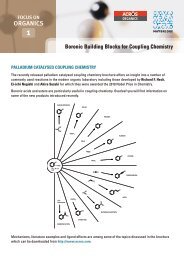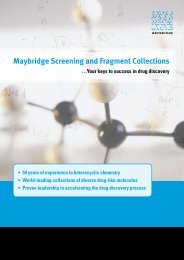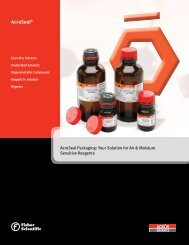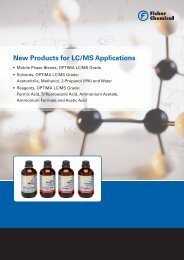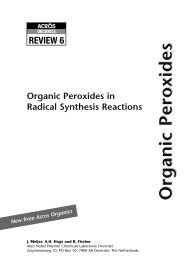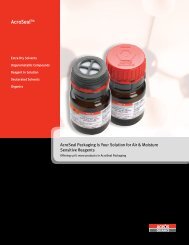Acros Organics Ultra Pure Inorganics
Acros Organics Ultra Pure Inorganics
Acros Organics Ultra Pure Inorganics
You also want an ePaper? Increase the reach of your titles
YUMPU automatically turns print PDFs into web optimized ePapers that Google loves.
<strong>Ultra</strong> <strong>Pure</strong> <strong>Inorganics</strong>Photovoltaic MaterialsMonocrystalline silicon,polycrystalline silicon,cadmium telluride (CdTe) andcopper indium/gallium selenide(CIGS) materials are commonlyused to develop solar energygenerators.CdTe is a thin film that can be deposited on substrates easilyand is an ideal semiconductor for photovoltaic applications.Its advantages include simplified manufacturing, it absorbssunlight efficiently,and there are abundant raw materials.CIGS is a thin-film that can be deposited on multiplesubstrates and performs with the highest efficiency of all thinfilms.Its advantages are the low relative cost of production,high efficiency, and flexibility of substrates available to bond.The main benefits of solar photovoltaicelectricity are:• Virtually zero environmental impact.• Low operating costs, once installed little maintenance cost.• Reliable operating systems.• Grid-connected solar electricity can be used locally thusreducing transmission/distribution losses.• Economically superior where grid connection or fueltransportation is difficult, costly or impossible (islands,satellites, ships).Typical <strong>Acros</strong> <strong>Organics</strong> products used inphotovoltaic applications include:Example products:Product ID Compound % Purity19319 Indium(III) Chloride 99.99531812 Tellurium(IV) Oxide 99.999519307 Gallium 99.999919398 Selenium(IV) Oxide 99.999Optical FibersHigh purity inorganics can be used as dopants in the glass coreand cladding of optical fibers to reduce attenuation by changingthe refractive index. They can also be used to amplify opticalsignals or lasers. The optical fibers have applications incommunications, sensors, lighting and analytical industries.A standard optical wire consists of the glass core, thecladding and the buffer coating.The core is made with a higher index of refraction, an opticalparameter that is a measure of the speed of light in the material,than the cladding, resulting in “total internal reflection”, or trappingthe light in the core and thus reducing attenuation or light intensityloss. The buffer coating protects the fiber from the environment.The main benefits of optical fibers are:• Lower cost to manufacture than copper.• Lower power usage needed to send signal and no need toboost signal once sent.• Lighter and thinner allowing for more fibers to be fit into a cable.• Higher capacity to transmit data (~1 terabit/second vs~50 megabits for copper).• Better signal integrity with little degradation.• Can be used in dangerous environments where electricalsignals could cause hazards (from pool lighting to flammableenvironments).Applications of optical fibers:• Communications• Sensors• Lighting• Medical probes/Medical imaging• Spectroscopy of large objects, permanent structures,gaseous environmentsTypical <strong>Acros</strong> <strong>Organics</strong> products used in opticalfiber applications include:• Dopants in glass core and cladding to reduce attenuation bychanging the refractive index.• Dopants used as amplifiers of optical signal or lasers.Typically Rare Earth Metals.Examples products:Product ID Compound % Purity19000 Germanium Dioxide 99.99943718 Ytterbium Chloride hexahydrate 99.99919302 Europium (III) Oxide 99.993



